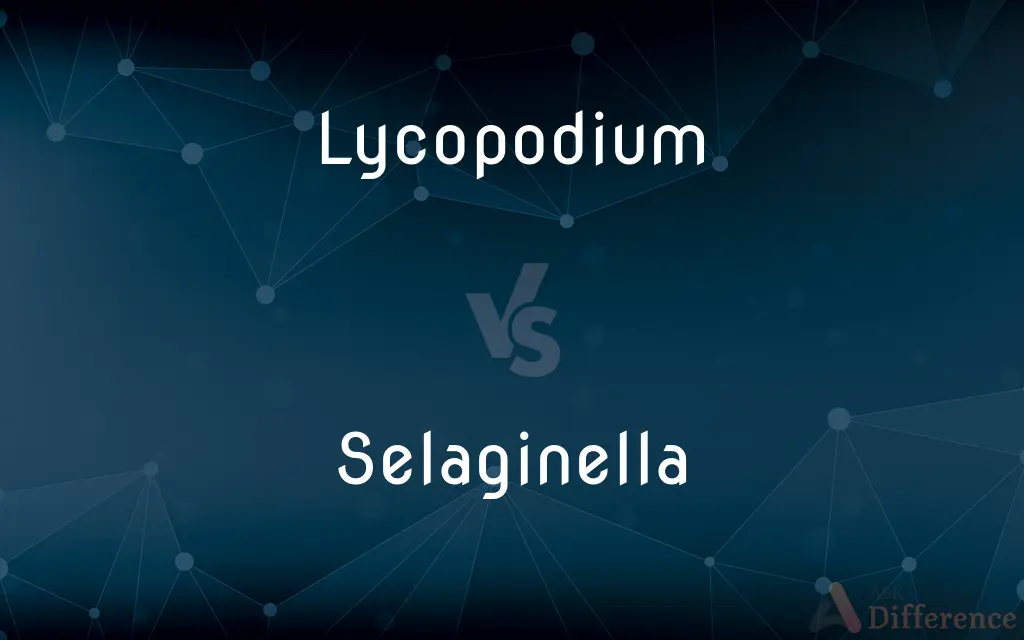Lycopodium vs. Selaginella — What's the Difference?
By Tayyaba Rehman — Updated on September 27, 2023
Lycopodium is a clubmoss genus, with simple vascular plants. Selaginella is a spikemoss genus, distinguished by heterospory. Both are non-flowering and belong to Lycopodiophyta.

Difference Between Lycopodium and Selaginella
Table of Contents
ADVERTISEMENT
Key Differences
Lycopodium and Selaginella, both hailing from the division Lycopodiophyta, represent two distinct genera of ancient vascular plants. Lycopodium, often referred to as clubmosses, has long, creeping stems with small, simple leaves. Selaginella, commonly called spikemosses, is characterized by its scale-like leaves and sprawling or upright growth.
A striking difference between Lycopodium and Selaginella lies in their reproductive strategy. Lycopodium produces a single type of spore, a condition termed homospory. In contrast, Selaginella is renowned for producing two different kinds of spores, termed heterospory, where it generates both large megaspores and smaller microspores.
While Lycopodium tends to favor temperate and cooler climates, Selaginella showcases its adaptability by thriving in a broader range of environments. Many Selaginella species, for instance, inhabit tropical rainforests, while others can be found in deserts, showcasing an impressive range of drought tolerance.
The morphology of Lycopodium is relatively simple, with a creeping growth form, whereas Selaginella displays a more diverse range of appearances. Some Selaginella species can be quite ornate, featuring iridescent blue leaves or a unique branching structure that's visually captivating.
In essence, both Lycopodium and Selaginella offer a glimpse into the early evolutionary stages of vascular plants. Yet, through their unique reproductive strategies and diverse habitats, they underscore the vast adaptability and evolution within the plant kingdom.
ADVERTISEMENT
Comparison Chart
Common Name
Clubmosses
Spikemosses
Spore Type
Homospory (single type)
Heterospory (two types: mega & microspores)
Preferred Habitat
Temperate and cooler areas
Varied, including tropical to desert areas
Leaf Appearance
Small, simple leaves
Scale-like leaves
Growth Form
Generally creeping
Sprawling or upright, sometimes iridescent
Compare with Definitions
Lycopodium
A genus of vascular plants known as clubmosses.
Lycopodium species are prevalent in temperate woodlands.
Selaginella
Spikemosses with scale-like leaves and unique growth forms.
The blue iridescence of some Selaginella species is captivating.
Lycopodium
Non-flowering plants with long, creeping stems.
The forest floor was dotted with the creeping tendrils of Lycopodium.
Selaginella
Vascular plants characterized by heterospory.
The unique heterospory of Selaginella sets it apart from other plants.
Lycopodium
Ancient plants producing a single type of spore.
Lycopodium showcases homospory in its reproductive cycle.
Selaginella
Ancient plants belonging to the division Lycopodiophyta.
Selaginella, like Lycopodium, belongs to the Lycopodiophyta division.
Lycopodium
Terrestrial plants with small, simple leaves.
The Lycopodium on the trailside had tiny leaves along its stem.
Selaginella
A diverse genus of plants termed spikemosses.
Selaginella species can be found in varying habitats worldwide.
Lycopodium
Lycopodium (from Greek lykos, wolf and podion, diminutive of pous, foot) is a genus of clubmosses, also known as ground pines or creeping cedars, in the family Lycopodiaceae. Two very different circumscriptions of the genus are in use.
Selaginella
Selaginella is the sole genus of vascular plants in the family Selaginellaceae, the spikemosses or lesser clubmosses. This family is distinguished from Lycopodiaceae (the clubmosses) by having scale-leaves bearing a ligule and by having spores of two types.
Lycopodium
A plant of the genus Lycopodium, which includes many of the club mosses.
Selaginella
Any of numerous often creeping or prostrate vascular plants of the genus Selaginella that bear spores, have small scalelike leaves, and are closely related to the club mosses. Also called spikemoss.
Lycopodium
The yellowish powdery spores of certain club mosses, especially Lycopodium clavatum, formerly used in fireworks and explosives and as a covering for pills.
Selaginella
Any of a group of ferny plants of the genus Selaginella, spike moss.
Lycopodium
Club moss
Selaginella
A genus of cryptogamous plants resembling Lycopodia, but producing two kinds of spores; also, any plant of this genus. Many species are cultivated in conservatories.
Lycopodium
A genus of mosslike plants, the type of the order Lycopodiaceæ; club moss.
Selaginella
Type and sole genus of the Selaginellaceae; evergreen mosslike plants: spike moss and little club moss
Lycopodium
Type and sole genus of the Lycopodiaceae; erect or creeping evergreen plants often used for Christmas decorations
Selaginella
Non-flowering plants with diverse appearances and habitats.
From rainforests to deserts, Selaginella showcases its adaptability.
Lycopodium
Plants belonging to the division Lycopodiophyta.
Lycopodium is a notable member of the Lycopodiophyta lineage.
Common Curiosities
Are Lycopodium plants found in tropical areas?
Typically, Lycopodium prefers temperate and cooler regions.
How does Lycopodium reproduce?
Lycopodium reproduces through a single type of spore, termed homospory.
What habitats does Selaginella occupy?
Selaginella is diverse, found from tropical rainforests to deserts.
What kind of plants are Lycopodium?
Lycopodium are non-flowering vascular plants, commonly known as clubmosses.
How is Selaginella different in spore production?
Selaginella is heterosporous, producing two distinct spore types.
Are there any ornamental species of Selaginella?
Absolutely, many Selaginella species are grown for their unique aesthetics.
Is Lycopodium used in any traditional remedies?
Yes, some cultures use Lycopodium in traditional medicines.
Can Lycopodium be grown in gardens?
Yes, some Lycopodium species are cultivated as ornamental plants.
Are Lycopodium and Selaginella related?
Both belong to the division Lycopodiophyta, showcasing their evolutionary relationship.
Why is Selaginella unique among vascular plants?
Its heterospory and varied appearance and habitat set Selaginella apart.
How does Selaginella cope in dry conditions?
Some species exhibit impressive drought tolerance, reviving after rainfall.
Share Your Discovery

Previous Comparison
Ampicillin vs. Amoxicillin
Next Comparison
Toxin vs. ToxicantAuthor Spotlight
Written by
Tayyaba RehmanTayyaba Rehman is a distinguished writer, currently serving as a primary contributor to askdifference.com. As a researcher in semantics and etymology, Tayyaba's passion for the complexity of languages and their distinctions has found a perfect home on the platform. Tayyaba delves into the intricacies of language, distinguishing between commonly confused words and phrases, thereby providing clarity for readers worldwide.















































